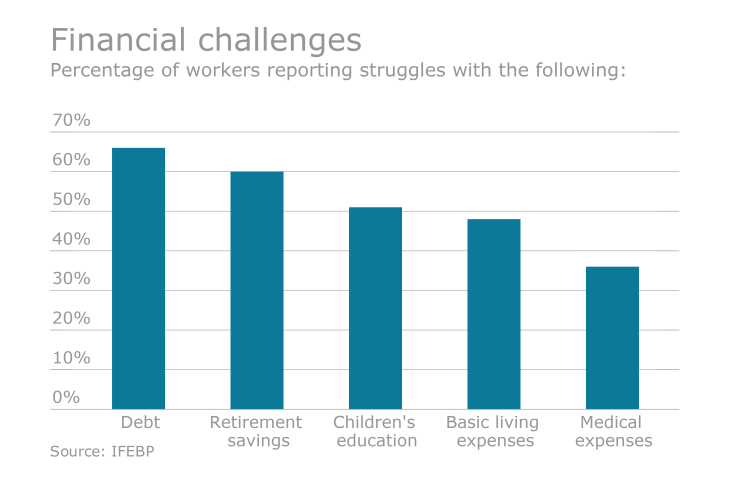The economy is growing and that’s a good thing. Employees, however, are still struggling with financial literacy, and many employers are feeling effects from employee stress.
Many benefit managers are recognizing the significant impact personal finances can have on an employee’s job performance and are putting in place programs to help workers get a better grasp on their finances.

According to a newly released study from International Foundation of Employee Benefit Plans, issues employees struggle with the most are debt (66%), followed by saving for retirement (60%), saving or paying for children’s education (51%), covering basic living expenses (48%) and paying for medical expenses (36%).
Employers are also noticing a particular stress on the “sandwich generation,” those workers who support both elderly parents along with children, with more than a quarter of employers noting these challenges affecting a significant portion of their workforce.
“Nearly half of organizations rate their workforce as only a little bit or not at all financially savvy,” says Julie Stich, IFEBP’s research director. “Employers are also reporting more financial challenges among employees today than five years ago and are seeing these challenges reflected in the day-to-day operations of their workplace.”
In an effort to help stem growing stressors, benefit professionals are offering more programs. Nearly half (49%) of organizations offer benefits literacy education, 45% offer retirement security education and 23% offer financial literacy education – including topics on investments, savings, insurance, budgeting and identity theft as well as retirement-focused issues such as retirement plan benefits, preretirement financial planning, retirement plan distributions and retiree healthcare.
The most popular education methods include voluntary classes, projected account-balance statements, retirement income calculators, online resources and free personal consultation services, the study notes.
Michael Rogers, CEO of iFocus: Human Capital Solutions, notes that organizations planning to implement financial education programs should consider the method of the program’s delivery.
“Financial planning can create feelings of anxiety and avoidance for many … providing several program delivery methods may increase program results.”
“Financial planning can create feelings of anxiety and avoidance for many … providing several program delivery methods may increase program results,” he says.
Two-thirds of organizations offering financial education rate their programs as successful, with free personal consultation services, voluntary classes and online resources reported as the top three successful methods. Fourteen percent of employers have a financial education budget, and 22% are considering it.
There are a number of reasons employers may want to consider offering financial education — to increase their employees’ ability to manage their money, improve employees’ retirement investment decisions and increase understanding of current benefits. And taking a page out of the wellness program handbook, more than one in ten organizations currently provide participation incentives for financial education and an additional 9% are considering doing so.
“We’ll be digging further into what strategies and program elements impact success. … In general though, there seems to be a lot of existing evidence showing how incentives can boost participation in different types of programs, but as with wellness programs, it all depends on how an organization defines success,” says Stich, adding that measuring ROI of a financial education program or incentives used for one is likely going to be very difficult.





